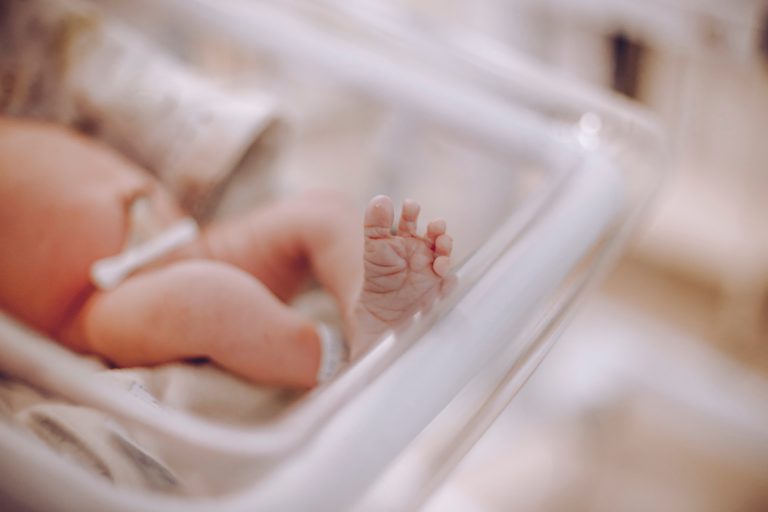Why Natural Birth Is the Safest For Mama and Baby
Are you a mama-to-be contemplating whether a natural birth is right for you? Well, first of all, congratulations on your new little one! A natural birth has so many benefits, but it seems more and more these days, women are choosing NOT to have a natural birth. Maybe you’re wondering if it’s safe or why someone would choose a natural birth. If so, read on mama!

(This post may contain affiliate links. You can read our full disclosure policy here.)
What is a natural birth?
In this post, a “natural birth” is referring to an unmedicated vaginal birth, without the use of medical interventions of any kind.
Why a natural birth?
You might be thinking, why would anyone in their ever-loving mind WANT a natural birth when there are way less painful methods to pop that sucker out?
Well for one, because it’s natural. There’s a reason birth is the way it is, pain and all, and there are many benefits to an unmedicated, natural birth for both mama and baby.
What are the benefits? Honestly, a whole book could be written on this subject (whole books HAVE been written on this subject) but before we discuss the benefits, it’s good to understand how medical interventions interfere with a natural birth and how they can affect you and your baby. By the end of this article, you too may decide that a natural birth is the way to go. (If you would like to jump straight to the benefits section of the post, click here.)
Before we continue, let me first just be clear about something: However you deliver your baby, whether C-section, induced labor, meds or no meds, birth is a miracle and you are amazing!!! Birth does not always go as planned. Mine surely didn’t! There are good reasons for medical interventions in life-threatening situations. And if you decide to do pain killers cuz you just can’t handle it, do it! You know your body better than anyone and what you can and cannot handle. Birth is not for the faint of heart no matter how you slice it. What’s MOST important is a safe mama and a healthy baby.
With that said, it is good to be educated and know your options! So before you accept any drug cocktail the hospital is ready to serve you up, it is important to understand how all these interventions affect you and your baby. Then you can make an educated decision and be somewhat in control of your own experience.
Is natural birth safe?
For as long as humans have been around, birth has been a natural, bodily function. Under normal circumstances, a healthy woman does not NEED medical intervention to give birth to a baby. We were MADE to do it.
To have a successful natural birth, though, it’s very important to prepare your mind and body so that you have the right mind-set going into it. I would even recommend doing a natural birth course to help you feel as empowered and as prepared as possible. There are many out there but I highly recommend this one by Mama Natural. It’s completely online (so you can stay on the couch with your feet up) and you can go at your own pace.
Of course, circumstances vary, and sometimes medical intervention is necessary. When it is, we can be thankful we have it! But when it is not necessary, giving birth naturally is definitely a safe option.
What is NOT safe is taking a casual view of medical interventions, since ALL of them have an effect on the natural progression of labor and can come with their own set of complications.
These common medical interventions include
- pain medicine
- Pitocin
- breaking the water
- antibiotics
- C-sections
You might be asking, don’t these things make birth safer?
This post is going to discuss how the medical interventions commonly used during labor and delivery affect both mama and baby, followed by the benefits of a natural birth.
Intervention #1
Pain Medicine
A pain-free birth is a pretty high selling point, and I don’t blame anyone for wanting or using them, but here are some other problems associated with them you may want to consider:
- It DOES affect the baby. No matter what people tell you, all drugs come with a measure of risk and can affect your baby either in a minor way or a major way. An epidural, for instance, can potentially affect your blood pressure, which can slow your baby’s heart rate. If a baby’s heart rate drops significantly, it can lead to an emergency C-section.
- Slows down labor. When you mute your body’s natural response to the pain, your contractions will slow down. When this happens, you may need Pitocin to speed things back up. Pitocin makes contractions even more intense AND painful, resulting in the need for more pain medication. See the vicious cycle?
- Harder to push. If you can’t feel the signals your body is giving you to push, it will be hard to engage those muscles, which can result in a longer pushing period or needing the baby to be pulled out by vacuum or forceps.
- Dulls your senses. Certain medications can make you feel loopy and out-of-it and not as engaged in the experience. It has been noted that babies of unmedicated mothers come out much more bright eyed and alert than those who received medication. A drowsy baby may also struggle with initial breastfeeding.
- Inhibits freedom of movement. Epidurals and other medications inhibit freedom of movement during labor, and movement helps labor progress. Even a “walking epidural” doesn’t mean you’ll be able to walk.
- Side effects. All drugs come with side effects. I can’t list them all here, but it is worth doing some research before you accept just anything they want to pump through your veins.
- It may not be pain free. I’m not speaking from experience on this one, but I’ve heard many say they still felt plenty of pain with painkillers.
Intervention #2
Pitocin
Pitocin is the drug they use to induce labor. It forces your body to have contractions. This may be necessary if the life of the mama or baby is in danger, and the baby needs to get out as soon as possible. Much of the time, however, induction happens simply because moms want a scheduled birth, or because you’re a day or two past your due date.
Pitocin makes natural labor VERY difficult and here’s why:
- It’s extremely painful. Pitocin intensifies your already-painful contractions. Your body has a natural rhythm in labor: your muscles contract and relax to give your body a break so you have strength for the next contraction. Contractions with Pitocin don’t necessarily follow your body’s rhythm and may alternate the forced contractions with natural ones, giving you NO break.
- Your baby may not be ready. When your baby is cooked and ready to come out, it will tell you. It’s not your body or a due date that decides when your baby is ready to come out. The BABY lets off a hormone that signals to your body when they’re ready. When we schedule a birth simply for convenience, we may be forcing the baby out prematurely which could lead to other complications, including longer hospital stays or time in the NICU.
- It leads to pain medication. Contractions with Pitocin are so strong it almost guarantees you’ll want pain medication such as an epidural. An epidural slows down labor meaning you’ll need more Pitocin. Remember the vicious cycle?
- Can cause postpartum hemorrhaging. This is extremely heavy bleeding. This happened to me, and it is a life-threatening situation for mama and baby.
Intervention #3
Breaking the Water
Often this is done to speed up labor. The amniotic sac that surrounds your baby keeps it safe and protected. Once the sac is broken, the baby is not as protected and is susceptible to infection.
When I was in labor, the nurses kept urging me to let them break my water to speed up the process. My midwife warned me that once they break your water at the hospital, you’re on a time clock. It used to be a 48 hour cushion, then it was 24, and now you have a 12 hour time limit to deliver your baby. Otherwise, you guessed it—emergency C-section.
My baby was not in danger, so I let my water stay in tact until I was at least 6cm dilated and was sure I could deliver in a reasonable time after they broke my water.
So here’s my tip: If your baby is not in danger, and your doctor okays it, let your water stay in tact as long as possible.
It is ideal to let it rupture on its own closer to delivery time. The longer your amniotic sac is in tact, the more protected your baby is from possible head trauma and infection.
Intervention #4
Antibiotics
Antibiotics are used in hospitals like Windex is in My Big Fat Greek Wedding. Something wrong? Just spray Windex on it! Someone not feeling well? Give ’em antibiotics! It’s the “fix-all” cure. Except that it’s not.
Antibiotics are only good for bacterial infection, not viral infections, but tend to be over used. Unfortunately, hospitals need to routinely administer antibiotics during all C-sections to prevent infection and even as a precaution during natural labor if the mother tested positive for Group B Strep.
So what’s the problem?
Antibiotics are meant to destroy any living bacteria in your body, good or bad. When you get antibiotics during labor, that goes straight to your baby and affects their good bacteria as well. Bacteria is the foundation of your baby’s immune system and helps them fight against infection and disease.
This is not to say you shouldn’t take antibiotics if you need them. If you have a bacterial infection, they are necessary and could be life saving for you or your baby. But knowing how they impact your baby, it’s best to take them ONLY when they are necessary.
If you do need antibiotics during birth, be sure to give your baby a good probiotic to help rebuild there microbiome.
Intervention #5
C-sections
An article entitled, Coronavirus Exposes the Business of Safe Birth in Forbes magazine states, “Although evidence supports that vaginal births are the safest way to deliver children, caesarean rates have significantly increased over the past decades from an average of 20% in 2000 to 28% in 2017 across high-income countries.” Yet statistics show that C-sections are life saving ONLY about 10-15% of the time. So why the increase?
- It’s a money maker. In the United States, the average cost of a vaginal birth, which can take many hours, is between $5000-$11,000 according to SmartAsset.com. Average cost for a C-section, which takes only 45 minutes, is $25,000. The price goes up if it’s a natural birth turned C-section— $50,000. Make more, work less. For hospitals, birth is a business.
- Less liability. Doctors and hospitals have a lower risk of being sued with C-sections as opposed to vaginal birth.
- Women are lead to believe it’s safer. Many women choose to have an elective C-section because they have been lead to believe this is the easiest and safest way to have a baby. This is not true. As simple as C-sections are made to look, they are still major surgery and carry the same risks as a major surgery, including a longer recovery time after birth.
As you can see, the medical interventions mentioned above are not free of risk, and in many cases, can add complications to an otherwise safe and natural process. Not only does a natural birth free you from everything mentioned above, it comes with many added benefits for both mama and baby!
So what are the benefits of a natural birth?

1. A more connected experience.
Birth is an intense, emotional experience, and it should be. The pain a woman experiences during labor releases oxytocin, the love hormone that bonds a mother to her baby. Pain medications can affect this intense emotional response and result in a more disconnected experience.
2. You can do it at home
If you are a healthy woman with a low-risk pregnancy, you may be able to give birth at home! At home you have total control over how and where you labor, the atmosphere you want to create, who’s at the birth, and baby’s after care. I’ve been a part of a few home births, and it is an incredibly beautiful and intimate experience. Plus, it’s cheaper than a hospital birth!
But you can have a completely natural birth experience even if you have to give birth at the hospital! (For tips on having a natural birth at the hospital, see my article here.)
3. No side effects
Without drugs you are not at risk of drug side effects, which can be mild or severe. During my own birth I had to be on a magnesium drip and it made me very drowsy and gave me dry mouth. It may sound mild, but pushing a baby out when your mouth is bone dry SUCKS. I had to suck ice cubes between each contraction because they wouldn’t let me drink water and it was awful. Which leads me to my next benefit of a natural birth…
4. You can eat and drink!
Giving birth is like running a marathon. Eating protein snacks and drinking electrolytes during labor gives you energy and the strength you need to keep going. At the hospital they don’t want you eating because they always want you to be “ready for surgery.” Sometimes it feels like they are just itching to get as many mothers as they can into a C-section. So instead of snacks, they hook you up to an IV; but anything running through your veins has the potential to slow labor down. If you’re giving birth at a hospital, you can put in your natural birth plan that you prefer freedom to eat over an IV.
5. Freedom of movement
During a natural birth you are able to move around and be in whatever position you like. This is very difficult (if not impossible) when you are hooked up to a bunch of machines and IV drips. Movement is so important to help labor progress and for you to be comfortable. In a natural labor, you can be lying on the floor, bouncing on a ball, or even in a warm bath tub with someone fanning you and feeding you grapes.
6. Exchange of healthy bacteria from mother to baby
This is probably my favorite and most fascinating benefit of a natural birth. When a baby comes through their mother’s vagina, they are exposed to TONS of microbes, and as it makes its way out, is completely coated in all this good bacteria. What’s even more interesting, is the type of bacteria that flourishes in those parts is Lactobacilli. Sound familiar? That’s the bacteria commonly found in yogurt because it is good at fermenting and digesting milk. The book Let Them Eat Dirt further explains
“Unknowingly, every mother seeds her baby with a special custom package of microbes that will best suit her baby’s needs. Babies instinctively seek their mother’s breast shortly after birth, and breast milk is exactly what these microbes need to flourish in the baby’s gut.”
—Let Them Eat Dirt by B. Brett Finlay, PhD and Marie-Claire Arrieta, PhD
How amazing is that??? The book further explains that another milk-digesting bacteria called Bifidobacterium is found in the mother’s feces. So if you push something out other than a baby during birth (like most women do) don’t fret! You’re just passing on more good bacteria to your baby! =)
7. Diversity in gut microbes
When babies receive all that good bacteria via vaginal canal, it sets a good foundation for their immune system and diversifies their gut flora. This affects them long term and can help prevent auto-immune disease, allergies, asthma, and obesity later in life.
8. It’s empowering
Every birth is empowering because no matter how you do it, it is a miraculous, life-changing experience. But a natural birth forces you to be intensely in tune with your body. When you feel every signal your body is giving you, every contracting muscle as it urges you to the next stage of labor, and you surrender to the process, it is a very empowering experience. You realize that no matter how many nurses or cheerleaders are surrounding you, ultimately it’s just you and your body powering through to bring this baby into the world. Birth is the ultimate human experience.
So yes! Not only are there many benefits of a natural birth but it’s a safe option as well!
But here is the key to having the safest birth possible…
Flexibility.
Why flexibility? Because if there is one thing I learned from my own birth experience, it’s nothing ever typically goes according to “plan” when it comes to birth. In fact, I think “birth plans” should really be called “birth hopes.” We may have the perfect vision of how we want our birth to go: the perfect playlist, candle-lit room, steady breathing, and out will pop a beautiful, slippery, crying child. Sometimes it goes that way (I’m stoked and envious of the moms it does lol) but A LOT of the time it doesn’t. AND THAT IS OK.
Everyone’s birth experience is unique and beautiful in it’s own way and the goal is the same— a safe mama, a healthy baby, and experiencing that over-the-moon-can’t-kiss-you-enough kind of love when you hold that baby in your arms for the very first time.
If you would like more information on this subject, these are my recommended reads!
- Let Them Eat Dirt by B. Brett Finlay, PhD and Marie-Claire Arrieta, PhD
- Natural Childbirth the Bradley Way by Susan McCutcheon
Are you considering a natural birth? I’d love to hear from you!








2 Comments